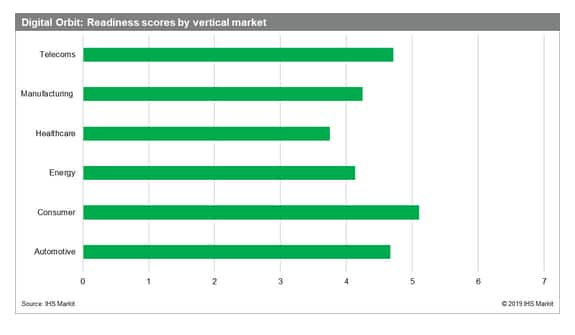If six of today’s most powerful transformative technologies were
tracked to gauge both their readiness for adoption and their
potential impact across six important industries, what would the
findings reveal?
This was the specific mission underlying Digital Orbit. The six
technologies are Artificial Intelligence (AI), Blockchain, IoT,
Video Everywhere, the Cloud and Virtualization, and 5G. The six
industries include automotive, manufacturing, healthcare,
telecommunications, energy, and consumer.
The extensive results from Digital Orbit indicate that the
consumer market presents the most accessible path of entry for most
transformative technologies, as shown by the graphic below,
followed by the telecommunications and the automotive sectors. This
is true when factors such as the culture, readiness, and investment
trends of a specific market are considered.

It was the consumer market, for instance, that warmed immediately
to IoT as shoppers fervidly embraced IoT devices. In fact, the
consumer segment represents more than 50% of the current IoT
installed base, counting smartphones in the group. In Video
Everywhere, the consumer segment accounted for more than $500
billion in revenue in 2018, far more than any other sector. In AI,
smart speakers make up one of the highest-volume applications to
date, with 39 million units shipped in 2018. The consumer industry
will likewise be at the forefront of adopting 5G, as initial
deployments align most tightly with consumer needs.
Why consumer?
Several reasons explain why consumer is the most porous layer
among all sectors for transformative technologies to penetrate.
Product development is quicker and replacement cycles are shorter
in the consumer segment, compared to the much longer times involved
in the industrial sector because of its relatively conservative
nature. Moreover, concerns related to privacy and liability are far
less burdensome in the consumer arena than in the industrial space.
In automotive and healthcare, for instance, the premature adoption
of a technology that subsequently fails can have devastating public
health and safety repercussions.
Given these considerations, it was not surprising that the
healthcare industry turned out to have the lowest readiness score
among transformative technologies. Compared to the consumer
segment, the healthcare sector is highly regulated, with
enterprises often having to deal with overlapping international,
federal, and local regulatory bodies. And very often, liability
concerns and regulatory compliance slow down the adoption of new
technologies in the healthcare industry. For these reasons,
healthcare is unlikely to be an early adopter of transformative
technologies, IHS Markit believes.
The beginning of the slowdown
While the consumer segment has been quicker than the industrial
sector in adopting transformative technologies, the tide will start
to change soon for some technologies. In IoT, for instance, the
consumer markets will begin to saturate by 2020 to 2030, with the
compound annual growth rate (CAGR) for consumer-related devices
during this period topping at approximately 17%.
During this time, however, IoT and other transformative
technologies will start to be adopted in earnest by segments like
energy and manufacturing. The CAGR for industrial-related devices
during the same 10-year period is projected to reach 25%.
Jenalea Howell is director of transformative
technologies at IHS Markit
Posted 17 June 2019